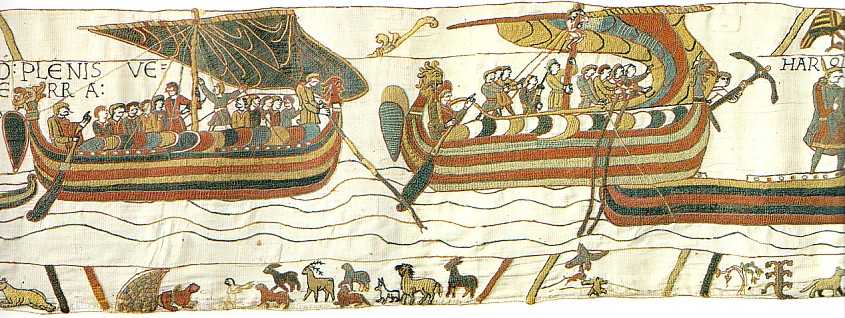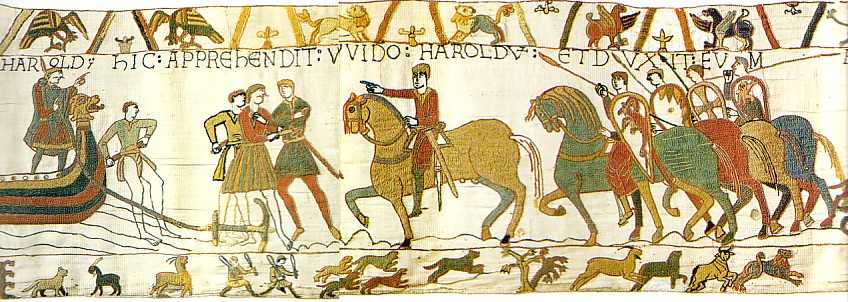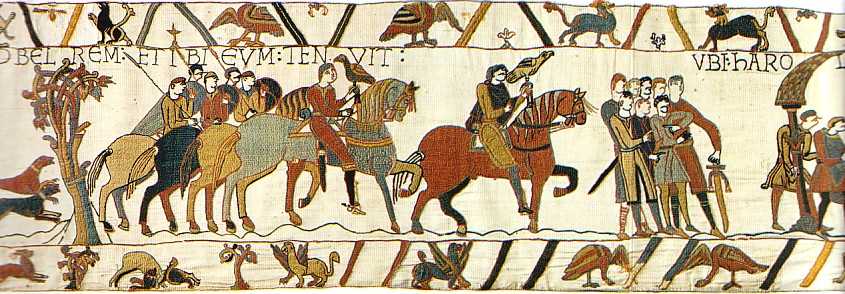
The curious custom of hanging a shield or pair of shields from the bow or stern is probably intended as a method of identifying the lord(s) of the ship to other sea traffic; or when entering port. Large ships towed in their wake little skiffs, like the one depicted to the rear of the second large ship (the first completely visible in this plate). The man in the bow is poling to discover bars or shallows while they maneuver close to shore; Harold mans the tiller. The third large ship (the second completely visible in this plate) depicts their arrival on the coast of Ponthieu; the forward men are using oars to help direct their approach in the lee wind; a sailor readies the anchor. Harold continues to man the tiller. The sail on the second ship is unique, and afterward the sails on all the ships are of a simpler shape.
Aesop's "The Lion King" is in the lower border - perhaps a metaphor of William. Another fable, "The Mouse, the Frog and the Kite" has caused scholars to identify Harold, Guy and William with the animal characters, as is natural with all the identified Aesop's fables appearing in the Tapestry - otherwise why include them at all?
HAROLD - HERE GUY HAS SEIZED HAROLD AND HAS TAKEN HIM...
Earl Harold holds a spear in the bow of the ship. And then, bare-legged to wade ashore, he is taken captive by count Guy of Ponthieu.(This is the second of several instances - multiple ships being the first - where the Bayeux Tapestry artists use duplicate images of the same character or object to show action.) Throughout these and the earlier scenes the English have no weapons except Harold's lone spear: and possibly in this scene, Harold and his two nearest compaions are armed with knives. Harold is already holding his out in front of himself, and the others seem to be depicted in the act of going for their knives, which are sheathed parallel to their belts behind their backs. I have a difficult time with the idea that Harold and his party of companions went across to see duke William of Normandy unarmed. Perhaps the English artists were sending a subtle hint to those who would view the Tapestry that the last "English" king was an innocent victim.
We get our first look at early "heraldry." All the English shields were blank on the ships. But Guy's knights sport four fascinating shield patterns (the knights ride casually without armor). The mixing of pagan and Christian motifs is typical of this period. The Normans were only a couple of generations beyond their Scandinavian origins.
The first time I ever examined the Tapestry closely was when I wanted authentic shield designs for painting my 25mm-scale Norman knights for my war-games army. I have used most if not all of those found on the Bayeux Tapestry. But one I know I have never used, because I do not care for it, is the poorly rendered "dragon" on the figure's shield on the right. It is either swallowing some tiny and hapless creature whole, or the tongue is far to huge.
The odd particoloring of the horses in the Tapestry has always struck me as very strange. Aside from making the artwork as colorful as possible, I wonder if this might not be a depiction of dyeing horses. Eastern armies - e. g. the Mongols - often organized their cavalry into units of like-colored horses; even applying distinctive dyed patterns to mark a unit's horses out. Later in the middle ages the bard of cloth for the knight's horse served the purposes of identifying him. Could earlier knights have experimented with dyeing their horses by conrois to be more easily recognized in battle? If this proves to be true, then my imagination will have to go through an adjustment, visualizing lines of charging mounted knights on horses painted blue, red, green, orange and in combinations of colors. Guy's horse is a good case: the mane is blue, the forelock is red, the far legs are also blue, the main body and near legs are a brown shade. The tail appears to be white. Gawdy to say the least! But typical throughout.
"The Fox and the Goat" followed by "The Lion's Share" keep pace with the scenes of Harold's capture.
...TO BEAURAIN AND HELD HIM THERE - WHERE HAROLD...
Nearly all of the horses in this part of the Tapestry, when viewed from the left side, show girthstraps cinched and the slack end hanging down. The figure immediately behind Harold has a girthstrap cinched on the right side and is probably an artist error.
Harold and his companions ride borrowed horses. The earl rides like a lord with a hawk on his gloved left hand. This is interesting behavior allowed someone who is potentially going to be released only if he pays a fat ransom. The rulers of the northern French coasts had this custom, that any traveler falling into their clutches would be kept prisoner until they paid for their release. Sometimes they were abused.
Loose hounds bound along in the company of the mounted party. They pause to sniff around and then run to catch up. You can almost see their actions by the way they are "drawn" in several different attitudes.
The rider behind Harold, already mentioned, also has a hawk and is meant to depict count Guy.




